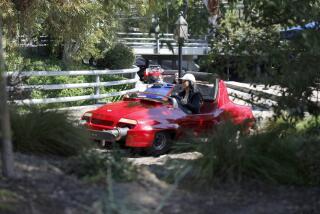Utah’s Cannibal coaster promises to ‘eat’ the competition
Roller-coaster enthusiasts are already planning pilgrimages to check out a fascinating new one-of-a-kind ride built by an in-house team of designers at an off-the-radar amusement park in Utah.
Set to debut this summer, the $22-million Cannibal at Lagoon outside Salt Lake City has been in the works for five years and will largely be designed, engineered, manufactured and built in-house with the help of in-state firms, a rarity in the amusement park industry.
With the exception of Disney, most big and small parks alike rely on major ride manufacturers in Germany, Switzerland and the Netherlands for off-the-shelf steel roller coaster concepts.
_____________
FOR THE RECORD
June 6, 2016, 8:30 a.m.: A quote in this article Lagoon spokeswoman Julie Freed lacked proper attribution. The quotation was from a prepared statement.
_____________
Even Disney will turn to the big ride makers for tracks and vehicles that are then carefully integrated into a themed environment dreamed up by Walt Disney Imagineering.
In hopes of building buzz for Cannibal, Lagoon officials have been secretive about some of the custom coaster’s details but bold in their boasts about the attention-grabbing ride.
“We have named it Cannibal because in our collective mind it will eat other roller coasters in their tracks,” said Lagoon spokeswoman Julie Freed.
In January, a video-equipped aerial drone that made several near-miss passes above and around Cannibal stoked excitement in the coaster community.
“What an impressive looking coaster,” said Michael Hammer of News Plus Notes, who has written extensively about Cannibal on the theme park fan site. “I know I’ve said that before, but honestly something of this size with so many unique features hasn’t come along in a while, so I’m quite enamored. I admit it.”
Cannibal will reach 70 mph and pull 4.2 Gs as it travels along a 2,735-foot-long track.
Climbing a 208-foot-tall enclosed tower, the 12-person trains will ascend a vertical elevator lift before descending a beyond-vertical, 116-degree first drop into a themed underground tunnel.
Along the way, the coaster will navigate three inversions, including a 140-foot-tall half-loop twist, a dive loop and a heartline roll, according to News Plus Notes. Other elements include an inverting top hat, a 360-degree helix over a man-made waterfall and a secret thrill that has not yet been announced.
The lapbar-only trains are expected to be similar to Lagoon’s Wicked coaster, with the addition of a third row of seats for greater capacity.
Lagoon designers have done a nice job of adding stone-carved lions, elephants and rhinos to the exterior. A plastic tarp has shielded a large themed portion of the attraction.
The home-made Cannibal was designed by Lagoon’s Dal Freeman, who also designed the the park’s 2007 Wicked tower launch coaster built by Germany-based Zierer.
With testing and inspections still underway, Lagoon was forced to postpone the March 28 debut of Cannibal during the spring shoulder season when the park operates on a weekends-only schedule. Lagoon’s summer season kicks off on June 5.
In addition to Cannibal and Wicked, the off-the-beaten-path Lagoon is home to a unique collection of rides not typically found at most amusement parks, including the only double-looping Schwarzkopf coaster still in operation, an 1893 hand-carved carousel and a 1921 wooden coaster by legendary ride designer John Miller.
In another break with industry tradition, the Lagoon-A-Beach water park is included with general admission to the amusement park.
Dating to 1886, Lagoon started as a lakeside resort with dining, music and dancing. Over the ensuing years, the weekend retreat slowly added increasingly thrilling amusement rides.
Known on the East Coast as trolley parks, such destination attractions were built and/or maintained by railroad companies as an incentive to get weekday business commuters to use the train lines for weekend leisure trips. Oceanfront pier parks on the West Coast were often built for the same reason, to lure city dwellers to the beach via rail services like the Pacific Electric Red Cars in Los Angeles.
MORE
32 best new theme park additions of 2015
Disneyland 2055: What the future may hold for the original Disney park
21 creepiest abandoned amusement parks
> Follow the Los Angeles Times Funland theme park blog on Twitter, Facebook and Google+
More to Read
Sign up for The Wild
We’ll help you find the best places to hike, bike and run, as well as the perfect silent spots for meditation and yoga.
You may occasionally receive promotional content from the Los Angeles Times.







